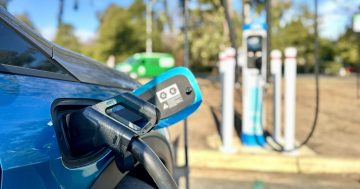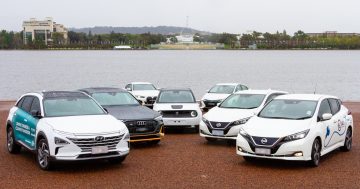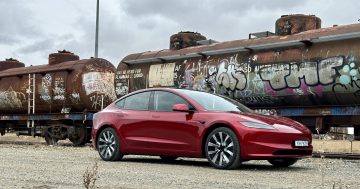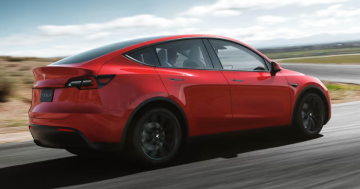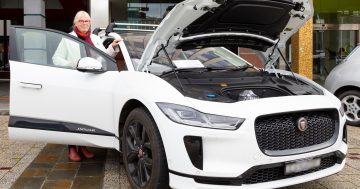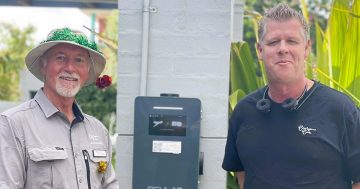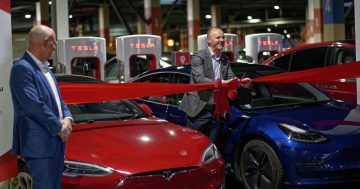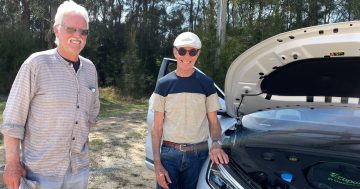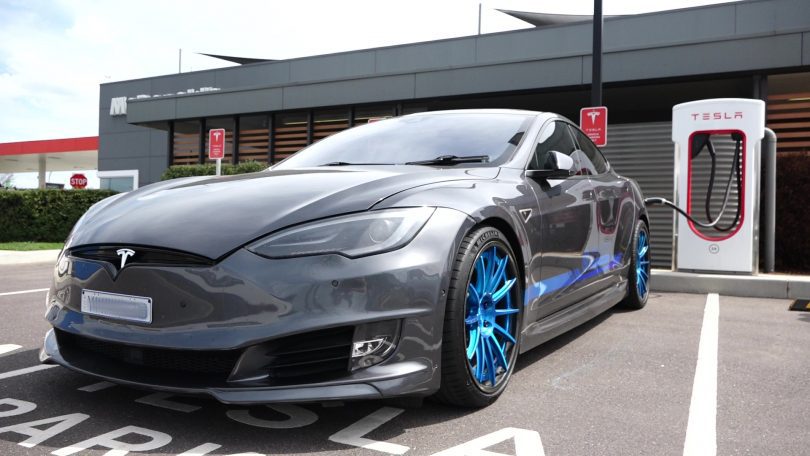
Hey, charger. A Tesla getting a top-up at Majura Park. Photos: Supplied.
I found this out the hard way when RiotACT published my article Canberra’s EVs lead the charge to celebrate the first World EV Day, which contained the claim that it takes eight hours to fully charge an electric car. So come 9 September, I decided to help myself to a large slice of humble pie and went to see the wide range of EVs gathering along Northbourne Avenue.
Adele Craven is the events coordinator for the ACT Branch of the Australian Electric Vehicle Association (AEVA). Her husband, Neil, serves as the admin for the private Tesla Owners ACT Facebook group. Together, they are the proud owners of a 2015 Tesla Model S P90D Ludicrous, modified by the Californian tuning house, Unplugged Performance.
Both are keen to bust some myths about electric vehicles.

Neil and Adele Craven are the very proud owners of a Tesla.
Myth 1: You could play a game of Monopoly while it’s charging
False.
Matter of factly, Neil asks: “How long does it take your phone to charge?”
And then he answers himself: “I don’t know – I plug it in when I go to bed and it’s charged when I get up. Well, it’s the same with a car.
“Even if you do 1,200 km to the Gold Coast for your holidays … there are fast chargers all the way along. You stop your journey maybe three times. You need to have those breaks anyway.”
A typical pitstop with a Tesla Supercharger takes 20 to 40 minutes.
Myth 2: EVs are really expensive
Not quite true.
ActewAGL and Tesla both offer charging facilities in the ACT. ActewAGL’s casual rates start at $2 per hour or a subscription can be purchased from $10 per month. Tesla chargers are free, and provided you have the correct adapter, the ‘Destination’ spec ones found at many shopping centres and hotels are available to any EV.
According to Zac, the technician at the Tesla service centre in Beard, routine maintenance for an EV is simple and involves checking the battery health, topping up the windscreen-washer liquid, cleaning the cabin filter, and that’s about it.
However, the cheapest EV currently on sale in Australia is the Hyundai IONIQ at over $45,000. The best-selling is the Tesla Model 3 starting at $74,000. Neil admits one like theirs would be about $200,000 new.
“Current ACT Government incentives are stamp-duty exemption on new vehicles only. There’s a 20 per cent discount on the registration component of a zero-emissions vehicle. And they let us drive on the transit lane on Adelaide Avenue, which is not a big deal,” Adele says.
Once more vehicles filter through into the second-hand market, the EV entry fee will drop.

Greens leader Shane Rattenbury dropped in on the World EV Day event.
Myth 3: EVs aren’t really that ‘green’ at all
The jury is still out.
Without getting bogged down in where the electricity is really coming from, zero-emissions come from the back of an EV.
The real issue is the batteries. A modern one can easily last 10 years and the technology is improving in leaps and bounds. But the volatile elements of nickel, cobalt and lithium all have to be mined and, if damaged, give off toxic fumes. Landfill isn’t an option, but lithium, in particular, is proving risky and costly to recycle.
Myth 4: Teslas aren’t reliable
That depends on the Tesla.
“We’ve had heaps of issues with our car. We’ve done 66,000 km in it and it’s been to Tesla service twice in that time,” Neil jokes.
The American manufacturer does remain at the top of the charts when it comes to things going wrong, but unlike almost any other car, this doesn’t always mean an eye-watering visit to the mechanics.
Neil goes on: “Because the car receives over-the-air software updates, you suddenly get new things that it didn’t do when you went to bed the night before. Minor bugs happen and they’re very quickly addressed in the next update.”
Myth 5: EVs are boring
False.
It’s true that few will find their hearts pounding to the thought of a Nissan Leaf but there is one fundamental advantage EVs have over internal combustion engines. Torque.
“The instantaneous full torque at zero revs that’s available to the electric motor makes all the difference,” Neil says.
“This car’s standing start to 100 km/h is 2.6 seconds, which puts it in the league of supercars. In fact, it beats most supercars.”
Just let me go out and gratuitously redline my little turbocharged VW Polo GTI a few more times and then I’ll be with you, Tesla. Once I’ve finished my pie.













